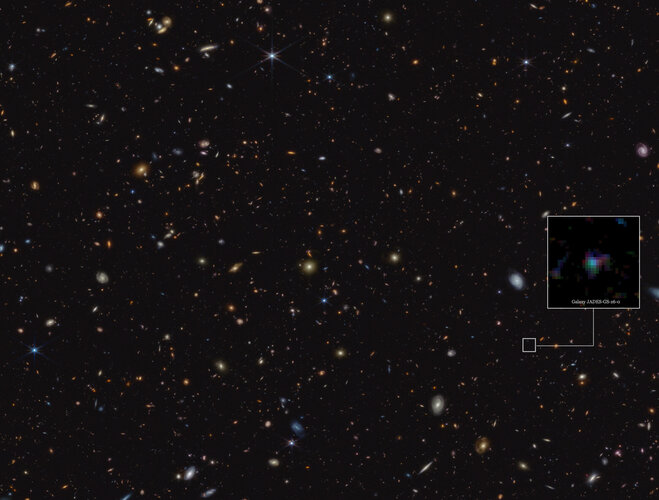
These observations were made as part of the JWST Advanced Deep Extragalactic Survey, or JADES, which devoted about 32 days of telescope time to uncovering and characterising faint, distant galaxies. This programme has facilitated the discovery of hundreds of galaxies that existed when the Universe was less than 600 million years old, including some of the farthest galaxies known to date. The sheer number and maturity of these galaxies was far beyond predictions from observations made before Webb’s launch. This new result of early-Universe dust grains contributes to our growing and evolving understanding of the evolution of stellar populations and galaxies during the first billion years of cosmic time.
“This discovery implies that infant galaxies in the early Universe develop much faster than we ever anticipated," adds team member Renske Smit of the Liverpool John Moores University in the United Kingdom. “Webb shows us a complexity of the earliest birth-places of stars (and planets) that models are yet to explain.“
The results have been published today in Nature.
Notes
[1] The Universe is expanding. The expansion is taking place at the fundamental spacetime level, which means that light travelling through the Universe is ‘stretched’ as the Universe expands. The earlier in the Universe the light originated, the more it will have been stretched by now. Practically speaking, this stretching of light means its wavelength becomes longer. This effect is known as cosmological redshift, because the colour red has the longest wavelength of all light visible to human eyes. Because of this, cosmological time is often not measured in years, but is indicated by the redshift of the observed light. The very local Universe — where the light we observe was emitted recently and has not been notably redshifted — has a low redshift. Conversely, redshift 7 corresponds to light that was emitted about 13 billion years ago, in the very early Universe.
[2] Astronomy fundamentally involves the study of light, and light travels at a finite speed (roughly 300 million kilometres per second). Objects can only be observed by humans once light from them has reached Earth. Whilst in some ways providing a limitation, this also provides a direct opportunity to study the early as well as the present Universe. Studying light from the early Universe necessarily entails the observation of regions very distant from Earth from which it takes a huge amount of time for light to travel to us. Thus, probing these early cosmological times (or high redshifts) requires very sensitive telescopes.
[3] All scientific measurements — including those from observations and those predicted by models — will have an associated error. This is because there will always be sources of uncertainty. If a measurement falls within the bounds of the expected error, it means that it could still be accurate: in this context, that means the 226.3 nanometre feature could still account for the same mix of cosmic dust as that represented by the 217.5 nanometre feature.
More information
Webb is the largest, most powerful telescope ever launched into space. Under an international collaboration agreement, ESA provided the telescope’s launch service, using the Ariane 5 launch vehicle. Working with partners, ESA was responsible for the development and qualification of Ariane 5 adaptations for the Webb mission and for the procurement of the launch service by Arianespace. ESA also provided the workhorse spectrograph NIRSpec and 50% of the mid-infrared instrument MIRI, which was designed and built by a consortium of nationally funded European Institutes (The MIRI European Consortium) in partnership with JPL and the University of Arizona.
Webb is an international partnership between NASA, ESA and the Canadian Space Agency (CSA).
Contact:
ESA Media relations



